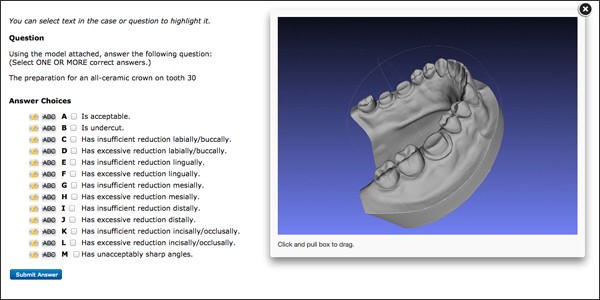Assessing Knowledge Application in Dentistry

Dental education is complex because the competent dentist not only needs to show competence in the many areas of clinical practice such as diagnosis and decision-making, they also have to demonstrate competence in a wide variety of clinical procedures by the time they complete dental school. In the clinical context, competency is just the starting point as the professional becomes proficient and expert over time.
Exam Master supports the evolution of the student from novice to competent by offering special tools for measuring knowledge application. Competency-based assessments must have a clinical context to be relevant in the health sciences. While all students must succeed in the didactic (knowledge acquisition) portion of their curriculum, programs must support their evolution into applying what they know or have learned to a clinical challenge or problem. There are no short- cuts here. Knowledge application is the starting point of this journey.

Exam Master’s Academic Manager supports an advanced test item type called Advanced Multiple Response (AMR). This item type can be used to assess clinical reasoning and clinical decision-making in ways that are efficient, effective, and flexible. How is this accomplished? The AMR question type features the presentation of a clinical scenario or interpretive clinical data (such as a patient chart, radiograph, EKG, etc.) that is coupled to a complex set of possible answer choices, all of which are assigned positive or negative point values.
Of critical importance, these assessments can include a “critical failure” component whereby selected answer choices can be tagged such that, if they are selected as a response, the question is automatically graded as incorrect. This is important for setting a tripwire for indicating a lack of competence in the subject matter being tested. Together with the extended answer set with positive and negative point values, coupled with the critical failure component, educators have a better tool for assessing clinical decision-making, clinical competence, and competence. While these item types require thought and planning to develop, they are easy to score!
